Kicking off Day 3
Bill: Hey, Chris, have we been out her in Cali for a month yet? Oh wait, it’s only day number three … wow, we’ve been busy!
Chris: Geez, young William, are you worn out already? We’re just three-fifths of the way done! Grab some coffee and put your writing hat on—there’s work to do.
Bill: This reporting live from the road business is definitely hard work, but this morning when we got to our first stop it sure felt like we were in a little piece of paradise surrounded by beautiful plants.
Dümmen Orange at the Ranch
Chris: You’re right about that. Dümmen Orange always picks a lovely location for their trial and the latest one, Filipponi Ranch Cellars (a winery) didn’t let us down. The wooded setting down in a little valley was a pretty backdrop for all their new introductions and programs—which were numerous and unexpected! That said, what did you see at Dümmen that our readers need to know about? Why don’t you start with the annuals before we get into the perennials and the … well, we’ll save the exciting new programs for the end!
Bill: Let’s kick this off with a new series of interspecific geraniums called Santana. Obviously, there are several interspecific geraniums on the market, including a very well-known industry leader, but Dümmen feels they’re bringing something new to the table with Santana. The key message here is extreme uniformity in habit and timing across the entire seven-color series, they say. All colors, even the White and Splash colors, time the same, with no PGRs, creating a true medium vigor series. Think bench runs and uniform combos.
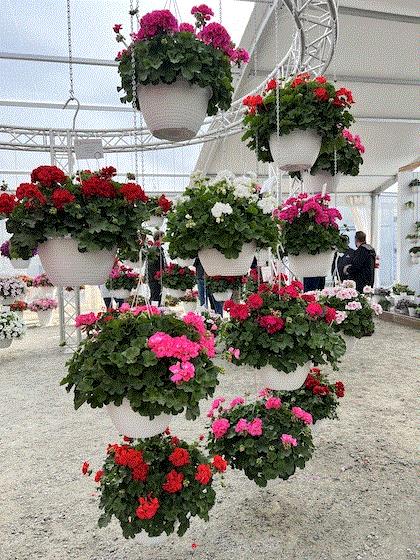
Santana interspecific Geranium
Chris: We like to see all-new series and another one at Dümmen is Petunia Smartunia. This eight-color, medium-vigor series touts Tobacco Mosaic Virus resistance, thanks to “Intrinsa.” What’s that? Well, it’s kind of hard to describe in one sentence, but in a nutshell, it’s using gene mapping to identify desirable traits that already exist within the genus or species, then taking advantage of those traits. It’s called “predictive breeding” because if you know the genes you have you can predict the traits your new variety will have. And it’s faster than old-fashioned techniques because rather than having to grow out the crosses to see if they have the trait you want, you just check their genes, which you can do when the new plant is tiny. Dümmen says by 2025 all their petunias will be TMV-resistant, thanks to Intrinsa. They’ve also used it to create white rust-resistant mums and powdery mildew-resistant kalanchoes (coming soon). It’s truly the future of plant breeding.
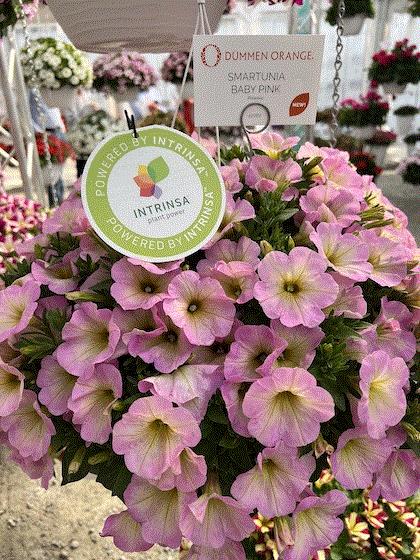
Smartunia Baby Pink Petunia
Bill: Intrinsa is a big deal, no doubt about it! Another key new release from Dümmen is the MegaGuinea series of New Guinea Impatiens. This series launches with four colors (Purple, Pink, Orange and White Blush), which Dümmen says you can produce using only one cutting per gallon. One cutting! I know our readers are going to love hearing that. While most other series recommend three cuttings in that size pot, this series was developed to reduce input cost and still result in great plants. And they’re fast—eight weeks to finish from a rooted cutting.
Chris: Don’t forget a couple other new New Guinea intros: The wavy-edged Roller Coaster series gets Orange; the medium-vigor Petticoat series gets Orange Swirl and Mango Swirl; and the big-flowered Magnum XL series gets Salmon.
Staying in the shade (or part sun) annual category, Begonia Bachelorette was a standout! It’s a standalone interspecific begonia that’s a cross of boliviensis and tuberosa. It’s got loads of flowers held just above the pointy leaves—it’s super tidy. We saw it in combinations and it looks like it “plays well with others,” as we like to say.
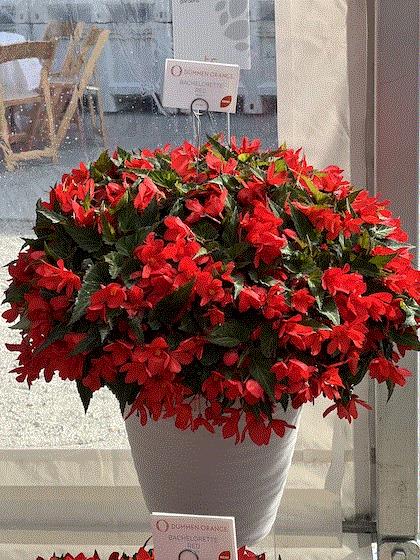
Begonia Bachelorette
Bill: Let’s close out the Dümmen annuals with one new color in the Tik Tok Calibrachoa series, Orange. Tik Toks came BEFORE the trendy Chinese website—its name for a pattern that look like little clock hands.
Chris: Here's where we surprise the folks with one of Dümmen Orange’s new crop categories: flowering tropicals, starting with hibiscus and dipladenia. The Hibiscus rosa-sinensis, called the Caribbean Collection, are bred in Spain and the Netherlands, giving them a broad range of environments to survive in. We were told they are less susceptible to bacterial leaf spot. The collection starts with just six colors, but they’ve more than 30 more in quarantine awaiting the selection process, so expect lots of pretty tropical hibiscus in this line. Stock will be produced domestically.
Bill: Does this mean I can reveal the other big program at Dümmen, boss? It was front and center at the ranch under the banner “Welcome to the Jungle”—their new indoor foliage collection. There’s a lot going on here from new production forms, like Sprouts (think peperomia from plantlets propagated like old-school African violets) to a new stock source in Antigua, Guatemala, where they’ve been building inventory for two years and are now ready to rock and roll.
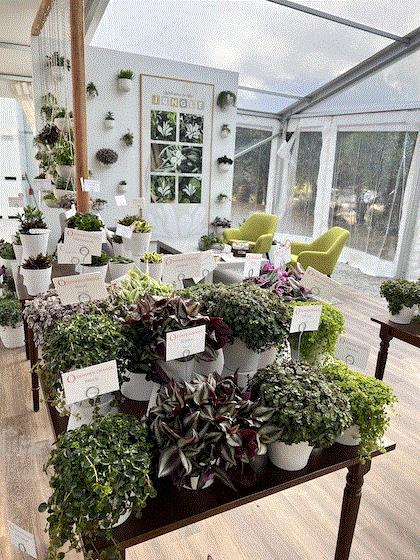
Chris: As a houseplant geek, I appreciate the large collection of peperomia, tradescantia and unusual succulents they showed, including some trendy items like string of dolphins. The real key will be if they can supply it because everybody is looking for a dependable supply of foliage!

Dümmen Orange’s Perennials
Bill: Dümmen has a strong perennials program and continues to bring grower-friendly solutions to the forefront. Take lavender for instance—the La Diva collection covers Spanish, French and the dentata species with options for all seasons. Last year, we told you about the La Diva English lavenders, but the message was clearer this year now that we’re back to SPRING Trials, not Summer Trials. Seeing them in full flower this early proved their claims that growers, even in the north, can produce a flowering crop to send to market in May. The trick is in the genetics, as well as stock management and shipping.
Chris: Can I write about a Dümmen perennial that grows from Zones 3 to 9? It’s Gaillardia Spintop. Now, these are vegetative, not from seed, so they’re true perennials, not biennials that come back from seed—that’s the difference. New to the collection is Mango, a breakthrough color, they say. Imagine, a perennial that will grow from Alaska to Florida!
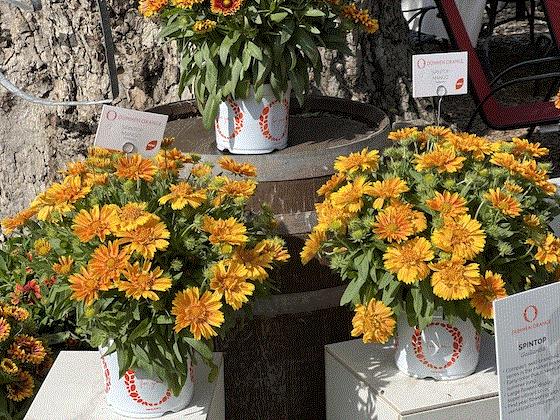 Gaillardia Spintop Mango
Gaillardia Spintop Mango
Bill: It’s not quite as versatile, but Dümmen has reselected their Pristine Penstemon series for cold hardiness. These are new genetics replacing the existing varieties. Princess Pink, Nightshade and Primrose are all first-year-flowering with no vernalization.
If you want to see all these and many more, watch our video HERE.

Sakata’s Flowers & Veggies
Chris: A two-hour drive up the coast, with you and Osvaldo writing and editing video in the backseat to help us keep up with all this work, and we arrived at Sakata, which was also hosting German breeding company Kientzler for the first time. We saw a new series, but some good color additions and some veggies at Sakata. I’ll start out with my favorite wintertime flowering plant, primula—what’s nicer than a pretty pot of primula to brighten a winter day when you live in Chicago? The new Dania series was bred in Denmark to be naturally compact, requiring no PGRs. But the flowers are large, giving a good show of color. Dania starts with eight colors.
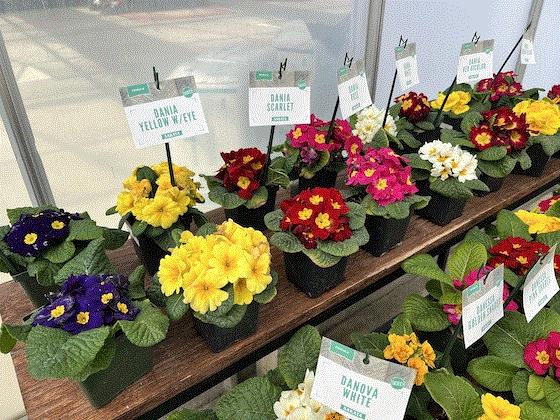
Primula Dania series
Bill: I may be covering the technical and cultural side of things these days for our Tech On Demand newsletter, but my roots are in retail, so I was excited to see some new marketing support for Sakata’s SuperCal collection. This petunia/calibrachoa cross (which they call a petchoa) gets an upgrade this year with a branded pot and tag program to call out the garden performance attributes at retail. That performance includes rain resistance, which they showed off using a water tunnel that would hose down a SuperCal and a regular petunia—which looked worse for the wear!
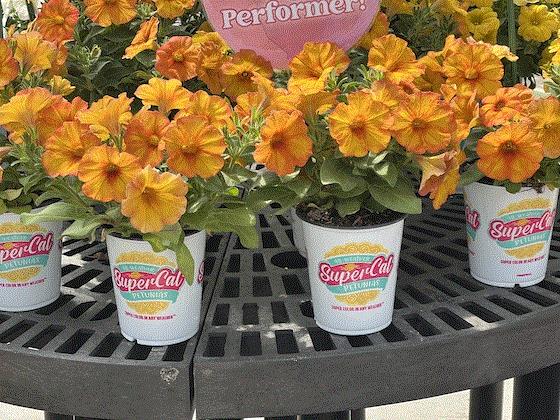 Petunia SuperCal series
Petunia SuperCal series
Chris: As I mentioned, we like new series, and Flamma is a new celosia series. These are big plants with big plumes, said to have longer-lasting flowers than the competition. It offers five colors. And another program we all know and love is SunPatiens, which gets four new compact varieties (Purple Candy, Lavender Splash, Classic White, Lilac Improved) and two new vigorous ones (Peach Candy, Pretty Pink).
Bill: Hitting Sakata right before lunch might have helped draw me to the new veggies because you know how much I love hot peppers. They had a handful of new ones that I want to try in my garden, especially Chaak habanero, Megatron hot jalapeño and Lone Ranger serrano. Chaak is a compact variety that’s two weeks earlier than most habaneros, while Megatron is early—only 65 days from transplant. Lone Ranger’s claim to fame is the size of the fruit—5- to 6-in. long.
Chris: I’ll leave you the hot pepper; tomatoes are more my speed. I tend to grow indeterminates to get fruit all season long, but I’d be willing to try these three new determinate types: Laguna Red, Rambler and Thunderbird. Laguna grows well in cooler conditions; Rambler has “huge” fruit with great flavor, they say; and Thunderbird sets fruit in the heat.
Bill: How about some broccoli to go with that? They also had three new broccolis with days to maturity that cover the entire season, from Kingdom (70 to 75 days) to Dynasty (80 to 85) to Empire (90 to 95). Last, but not least, was a collard called Top Chop with large leaves and small stems, resulting in more bang for the buck in the kitchen.
We covered all these and more in our VIDEO from the trial.

At Kientzler
Chris: After touring Sakata’s trial, we ducked into an adjacent greenhouse to see a few new intros from German breeder Kientzler, there first time exhibiting at Sakata. They offered an eclectic selection of new offerings, starting with some fuchsias—the first we’ve seen this week, in fact! The Stand-Up collection is named for its vertical, rather than hanging basket habit. New, however, are two Stand-Ups that have upward-facing flowers. Helena has red-and-white flowers, while Red/Lavender has … well, I don’t need to tell you the flower color.
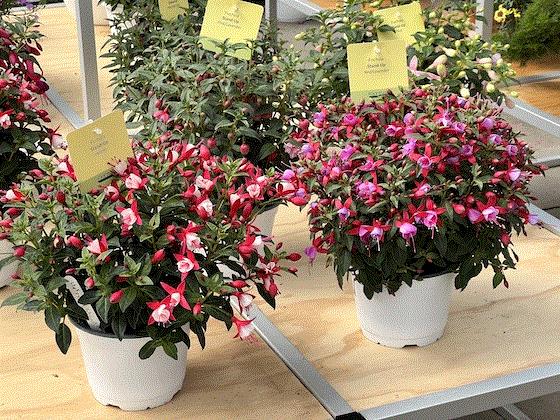
Fuchsia Stand-Up Helena, Red/Lavender
Bill: A standout for me was Bidens Spicy Electric White, one of three standalone bidens from Kientzler. The blooms are striking white with a bright yellow center. The other two varieties, Fire Wheel and Tiger Bee, will grab attention at retail, as well.
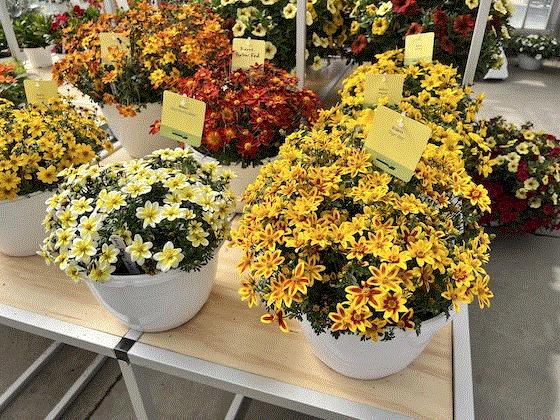 Bidens Spicy Electric White, Tiger Bee
Bidens Spicy Electric White, Tiger Bee
Chris: I’ll wrap up Kientzler with a new petunia series called Kayamba. We were told it means “strong” in some African dialect (although we could not confirm that; if any of you know, email me at beytes@growertalks.com). Kayamba is bred for the landscape, with a “dense, but vigorous” habit. It’s not daylength neutral, but it’s early, said to be able to be in bloom by March. Six colors: Red, Pink, Blue, Purple, White, Pink Vein.

Talking Takii
Bill: After wrapping up at Sakata, we continued across Highway 101 to Takii, another stop we’ve been going to for years. The first product we encountered is one we’ve come to expect, kale, because Takii is one of the kings of of the crop. They're showcasing new introductions in two kale series this year, Crystal and Kamome. Crystal is fringed, and adds Deep Red and Pink. Kamome is more frilly and the new colors are white and red.
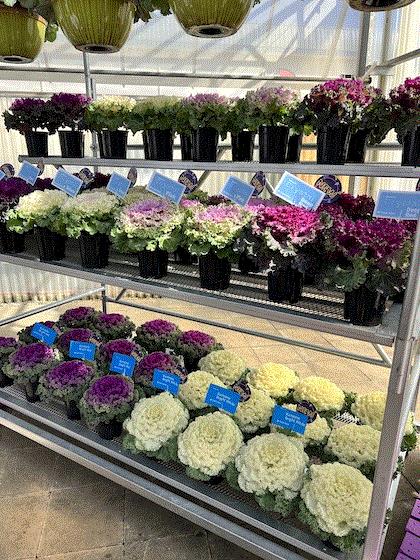 Kale Crystal (top) and Kamome (bottom)
Kale Crystal (top) and Kamome (bottom)
A cultural tip on kale: We learned that Takii’s technical experts advise growers not to cut off nutrition late in the crop cycle or you’ll run into problems. Instead, keep the EC consistent and lower the ppm and put them on constant feed until temperatures drop below 60F, after which you can stop the feed as they color up. Also, apply PGRs early in the crop, not late, for best results.
Chris: Speaking of kale, they’ve got a new cut flower subseries of Takii’s popular Crane series called Crane Ruffle, featuring four ruffled colors—Red, Rose, White and Bicolor. All these Crane kales are ideal for newbie cut flower growers, they say, because they’re easy to produce and forgiving.
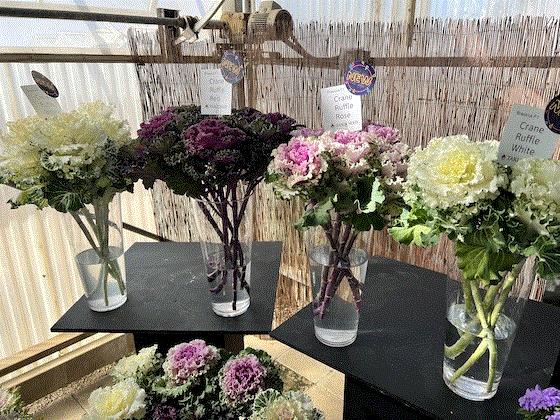
Cut Flower Kale Crane Ruffled
Bill: In Takii’s petunias, Opera, the low spreading type, adds Rose; while Trilogy, which is more mounding and spreading, gains Silver Blotch, which has an almost-white flower with dark purple to black centers.
Watch our VIDEO to see these new offerings from Takii.

HilverdeFlorist & That's a Wrap
Chris: Also exhibiting at Takii was HilverdeFlorist, a Dutch breeder known best for gerbera (but that’s not all they do). Their Garvinea Gerberas are great for garden performance and the Sweets are their traditional single-flowered gerberas. Two new ones are Vibe (yellow) and Sparkle (rose). But we especially liked the new subseries called Garvinea Cheeky, with loads of small flowers on vigorous plants. Cheeky is Zone 7 hardy and gets four colors: Red, Yellow, Magenta and Orange.
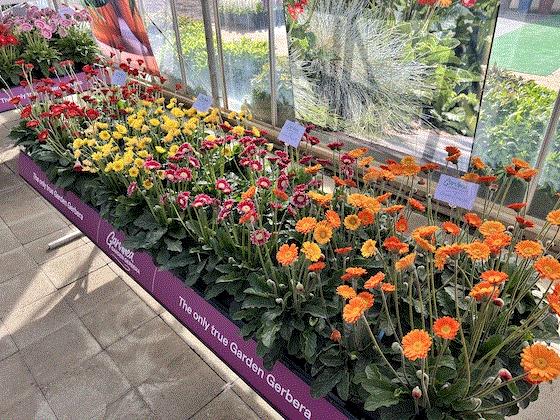 Gerbera Garvinea Cheeky
Gerbera Garvinea Cheeky
Bill: Sure, HilverdeFlorist is well known for gerbera, but they also have other crops in their portfolio, including salvia. The Sangoon collection includes some awesome varieties that can grow extremely tall, so now they’ve introduced the Lake series of more compact plants. The five colors in the series are all named for famous lakes around the world—Garda, Titicaca, Onega, Baikal and Victoria. These can be finished in a gallon pot from just one URC with no PGRs, as long as you pinch them once at the time of transplant.
Chris, I think that puts a bow on day three, right?
Chris: Puts a bow on it and ties it up tight! Next up for us: tours of Danziger and Syngenta. Stay with us for that! And let me remind you that we are posting more videos every day, so check out our Spring Trials 2022 playlist to see them all. And did we mention they're in 4K? Watch them on your biggest screen for the highest of high fidelity. (A note: We had a failure with our Ball Ingenuity link from Tuesday, so we reposted that video to the playlist.)
See you tomorrow!




Thanks for reading! See you next time,
Chris, Jen & Bill
Chris Beytes
Editor
GrowerTalks/Green Profit
Jen Zurko
Managing Editor
GrowerTalks/Green Profit
Bill Calkins
Senior Editor/Digital Editor
GrowerTalks/Green Profit
This email received by 31,370 lucky folks, and you're one of them!
Want to be one of the lucky sponsors who reach those 30,976 readers of Acres of Buzz from Spring Trials? Drop Paul Black a line and he'll tell you what a bargain it is!